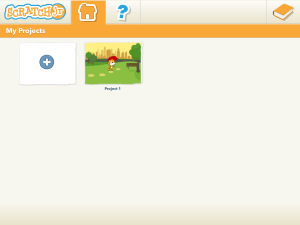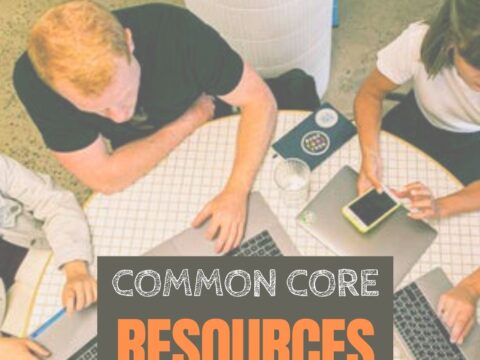ScratchJr
ages 5-7
Free
Overview
ScratchJr (released July 2014) is an introductory programming language for ages 5-7 similar to the wildly popular Scratch (for 3rd grade and up). ScratchJr adjusts Scratch’s interface and programming language to make it developmentally appropriate for pre-readers with features that match young children’s cognitive, personal, social, and emotional development. For example, optional video directions are all visual–no reading required. No voice even!
ScratchJr treats programming (a term that frightens even adults) as simply a creative way to communicate–another language. Start by opening the app:
Click the ‘Home’ icon to access saved projects or open a new one:
Write interactive stories and invent games by snapping together graphical blocks that make characters move, jump, dance, and sing. Modify characters in the paint editor, place them against different backgrounds, add sounds including your own voice, even insert personal photos:
Pros
With lively sounds, creative colors and shapes, ScratchJr does an excellent job of making programming available to early learners–before they learn how scary it is! Screens are bright without being distracting, sounds enticing without being overwhelming. The focus always remains on writing the story, building the game, and/or creating the video. No ads interfere with student work.
Cons
There is some discussion about whether programming aimed at students who can’t yet read is appropriate.
There is no way to export student work. A work-around would be to video the project using a screencast app like Explain Everything and then share it. Let’s hope the developers come up with a better method soon.
Insider tips
If you don’t know how to program, don’t worry. Scratch Jr. is about exploration, trial-and-error, and discovery. It’s not about you as teacher being the purveyor of perfect knowledge. Give students the iPad. Point them in the right direction, and let them go. They will discover everything they need. It’s not about product; it’s the process–critical thinking, problem solving and creativity.
Educational Applications
This is a great tie in for the Common Core K-1 Standards for Mathematical Practice. Additionally, use it in digital storytelling and recreating events in science and literacy units. Understand that the project will be as much about habits of mind as the specific inquiry topic addressed.
Conclusion
Because the app is expected to be self-taught and self-paced, students are empowered to learn on their own terms–no parent help required. No surprise they routinely rise to the challenge.
Jacqui Murray has been teaching K-18 technology for 30 years. She is the editor/author of over a hundred tech ed resources including a K-12 technology curriculum, K-8 keyboard curriculum, K-8 Digital Citizenship curriculum. She is an adjunct professor in tech ed, Master Teacher, webmaster for four blogs, an Amazon Vine Voice, CSTA presentation reviewer, freelance journalist on tech ed topics, contributor to NEA Today, and author of the tech thrillers, To Hunt a Sub and Twenty-four Days. You can find her resources at Structured Learning.









































